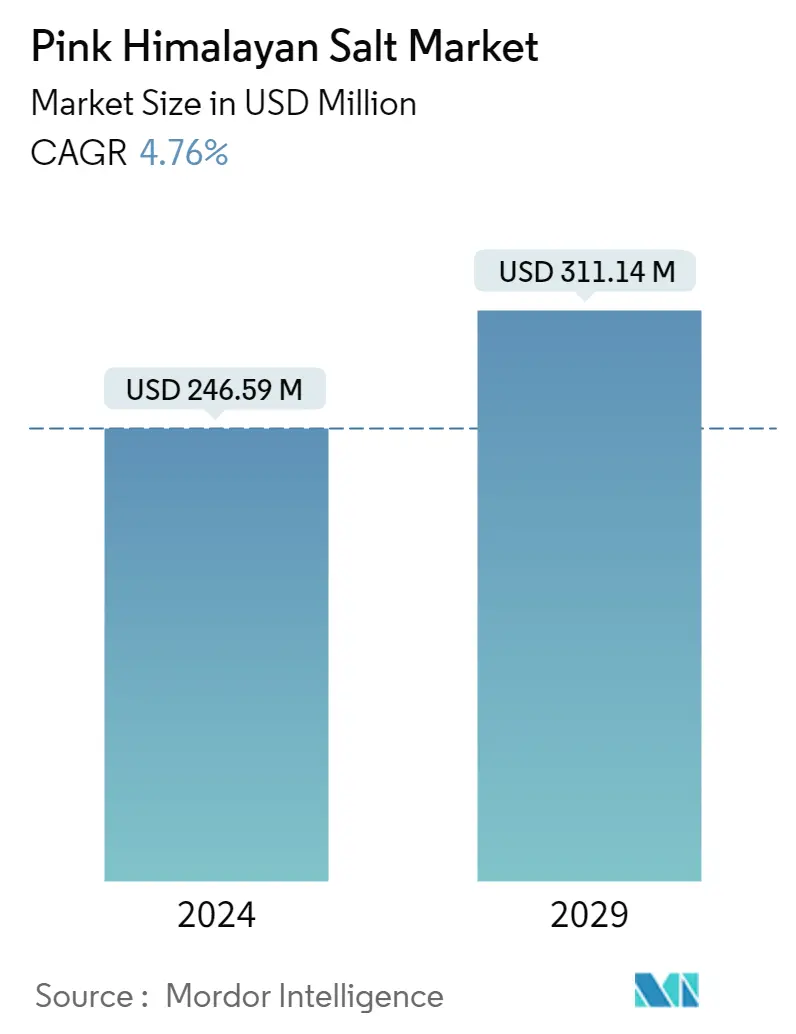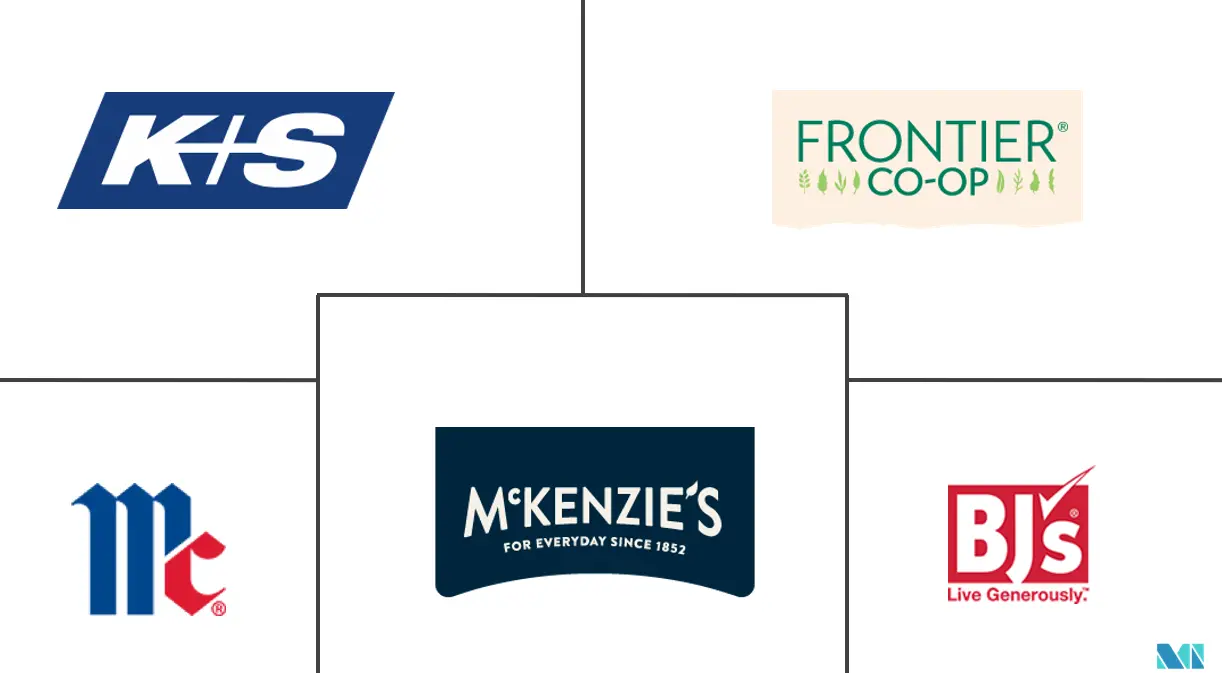Market Size of Pink Himalayan Salt Industry

| Study Period | 2019 - 2029 |
| Market Size (2024) | USD 246.59 Million |
| Market Size (2029) | USD 311.14 Million |
| CAGR (2024 - 2029) | 4.76 % |
| Fastest Growing Market | Middle-East and Africa |
| Largest Market | North America |
| Market Concentration | Medium |
Major Players
*Disclaimer: Major Players sorted in no particular order |
Pink Himalayan Salt Market Analysis
The Pink Himalayan Salt Market size is estimated at USD 246.59 million in 2024, and is expected to reach USD 311.14 million by 2029, growing at a CAGR of 4.76% during the forecast period (2024-2029).
- Pink Himalayan salt is a premium-priced culinary salt and a type of gourmet salt. Most of it comes from one of the largest rock-salt mining operations in the world, namely, the Khewra Salt Mine in the Punjab Region of Pakistan. The pink color of the salt comes from various mineral impurities, especially iron and other trace elements. The market for pink Himalayan salt is influenced directly by trends in the food industry, particularly in the fast-food and meat industries.
- On the other hand, pink salt is gaining popularity because of the increasing demand for gourmet foods. For example, consumers in the countries, such as the United States, the United Kingdom, France, and Italy, among others, are upgrading to gourmet salt from ordinary table salt. As a result, smoked, sea, and pink salts are moving toward the mainstream.
- Globalization and the strong influence of westernization in emerging countries fuel the demand for foreign cuisines, such as Italian and French food, which call for specialized flavors and seasonings, driving the demand for pink Himalayan salt in the market. Moreover, there is also a growing opportunity for organic flavored salts from all-natural ingredients. In addition, the introduction of blends of this salt is one of the latest trends that will contribute to the growth of this market in the forthcoming years.
- However, the increasing incidence of toxic chemicals reported in Himalayan pink salt across the globe is anticipated to hinder market growth in the near future. For instance, in 2020, the independent research company Nutrition Research Australia (NRAUS) tested 31 samples of pink salts available in Australia and found that the samples were unreliable and contaminated.
- Furthermore, the Covid-19 lockdowns worldwide in 2020 and limitations in 2021 interrupted the supply chain, presenting challenges for Pink Himalayan salt manufacturers. Moreover, vendor profit margins have continued to be squeezed by fierce competition, price challenges, and altering consumer preferences.
Pink Himalayan Salt Industry Segmentation
Pink Himalayan salt is a type of rock salt that is mined from the Khewra Salt Mine in the Punjab region of Pakistan. The salt gets its pinkish hue from trace minerals, such as iron, magnesium, potassium, and calcium, that are present in the salt. Pink Himalayan salt is popular as a healthier alternative to refined table salt because it is less processed and contains more minerals. It is often used in cooking and food preparation, as well as in food presentation, due to its attractive pink color.
Distribution channel, the market is segmented into supermarkets/hypermarkets, convenience stores, online retailers, and other distribution channels. The report also analyzes the emerging and established geographical regions by covering regions such as North America, Europe, Asia-Pacific, South America, and Middle East, and Africa.
The report offers market size and forecasts in value (USD million) for the above segments.
| Distribution Channel | |
| Supermarket/Hypermarket | |
| Convenience Store | |
| Online Retailer | |
| Other Distribution Channels |
| Geography | ||||||||
| ||||||||
| ||||||||
| ||||||||
| ||||||||
|
Pink Himalayan Salt Market Size Summary
The Pink Himalayan Salt market is experiencing a notable expansion, driven by its status as a premium culinary salt sourced primarily from the Khewra Salt Mine in Pakistan. This market is significantly influenced by trends in the food industry, particularly the growing demand for gourmet foods in regions like the United States, the United Kingdom, France, and Italy. As consumers increasingly shift from ordinary table salt to gourmet options, pink Himalayan salt is becoming more mainstream. The globalization and westernization of cuisines, alongside the rising popularity of organic flavored salts, are further propelling market growth. However, challenges such as the presence of toxic chemicals in some Himalayan pink salt products and supply chain disruptions during the Covid-19 pandemic have posed obstacles to market expansion.
In the Middle East, the market is witnessing substantial growth due to heightened awareness of the health benefits associated with pink Himalayan salt, particularly among millennials and Generation Z. The salt's mineral profile is appealing in regions like the United Arab Emirates, where it is used as a natural electrolyte solution. The market is moderately fragmented, with numerous players offering various product innovations and focusing on packaging to meet consumer preferences for environmentally friendly options. Major companies are investing in research and development to enhance product offerings, while new entrants are attracted by the relatively low processing requirements. Recent developments, such as the launch of a fully automated manufacturing facility in the UAE and the introduction of Himalayan pink salt in India, highlight the dynamic nature of the market.
Pink Himalayan Salt Market Size - Table of Contents
-
1. MARKET DYNAMICS
-
1.1 Market Drivers
-
1.2 Market Restraints
-
1.3 Porter's Five Forces Analysis
-
1.3.1 Threat of New Entrants
-
1.3.2 Bargaining Power of Buyers/Consumers
-
1.3.3 Bargaining Power of Suppliers
-
1.3.4 Threat of Substitute Products
-
1.3.5 Intensity of Competitive Rivalry
-
-
-
2. MARKET SEGMENTATION
-
2.1 Distribution Channel
-
2.1.1 Supermarket/Hypermarket
-
2.1.2 Convenience Store
-
2.1.3 Online Retailer
-
2.1.4 Other Distribution Channels
-
-
2.2 Geography
-
2.2.1 North America
-
2.2.1.1 United States
-
2.2.1.2 Canada
-
2.2.1.3 Mexico
-
2.2.1.4 Rest of North America
-
-
2.2.2 Europe
-
2.2.2.1 United Kingdom
-
2.2.2.2 Germany
-
2.2.2.3 France
-
2.2.2.4 Spain
-
2.2.2.5 Italy
-
2.2.2.6 Rest of Europe
-
-
2.2.3 Asia-Pacific
-
2.2.3.1 China
-
2.2.3.2 Japan
-
2.2.3.3 India
-
2.2.3.4 Australia
-
2.2.3.5 Rest of Asia-Pacific
-
-
2.2.4 South America
-
2.2.4.1 Brazil
-
2.2.4.2 Argentina
-
2.2.4.3 Rest of South America
-
-
2.2.5 Middle East and Africa
-
2.2.5.1 United Arab Emirates
-
2.2.5.2 South Africa
-
2.2.5.3 Rest of Middle-East and Africa
-
-
-
Pink Himalayan Salt Market Size FAQs
How big is the Pink Himalayan Salt Market?
The Pink Himalayan Salt Market size is expected to reach USD 246.59 million in 2024 and grow at a CAGR of 4.76% to reach USD 311.14 million by 2029.
What is the current Pink Himalayan Salt Market size?
In 2024, the Pink Himalayan Salt Market size is expected to reach USD 246.59 million.

